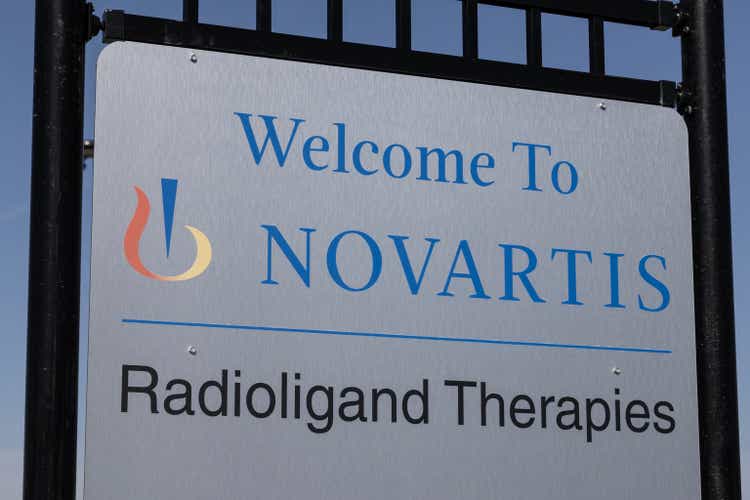
jetcityimage/iStock Editorial via Getty Images
The market for radioligand therapies (RLT), also known as radiopharmaceuticals, a relatively new kind of treatment, is expected to soar between now and 2030, with Novartis’ (NYSE:NVS) Pluvicto expected to account for the lion’s share as a prostate cancer therapy.
Pluvicto (lutetium [177Lu] vipivotide tetraxetan), which won FDA approval in 2022, is fast becoming the dominant RLT for prostate cancer, according to GlobalData. The data and analysis firm wrote that while the treatment brought in $963M in revenue in 2023, that figure is expected to jump to over $1.5B in 2024 and ~$4.3B in 2020.
The medicine is approved for prostate-specific membrane antigen (PSMA)-positive metastatic castration-resistant prostate cancer (mCRPC) who have been treated with androgen receptor pathway inhibition and taxane-based chemotherapy.
Although Pluvicto is not the first RLT approved for prostate cancer — that goes to Bayer’s (OTCPK:BAYZF) Xofigo (radium-223 dichloride), which was approved in the U.S. in 2013 — Xofigo’s revenue pales in comparison to Pluvicto’s. GlobalData projects Xofigo sales of just $244M in 2024, declining to $161M in 2030.
Additional RLTs could come from Bayer (OTCPK:BAYRY) given its May 2023 partnership with Bicycle Therapeutics (BCYC) to develop radiopharmaceuticals.
Thomas Wales, an oncology and hematology analyst at GlobalData, comments, noted that Pluvicto’s strong trial results will propel its growth. “Clinical appraisal of Pluvicto in the Phase III VISION trial successfully showed Pluvicto improving imaging-based progression-free survival (PFS) when compared to standard-care treatments such as Astellas Pharma’s (OTCPK:ALPMF)(OTCPK:ALPMY) highly popular Xtandi (enzalutamide),” he said, adding that median PFS survival with 8.7 months with Pluvicto compared to 3.4 months with standard of care treatments.
“In a landscape where prostate cancer recurrence and androgen deprivation therapies (ADT) resistance are commonplace, Pluvicto has made a clear impact in the mCRPC treatment paradigm,” Wales wrote.
He added that Novartis recently submitted an application to expand the indication for Pluvicto to include individuals who have yet to receive taxane-based chemotherapy which, if approved, would expand the potential patient market.
Astellas (OTCPK:ALPMY) reported Xtandi revenue of JPY750.5B (~$5.2B) IN 2023.
Novartis is also seeking to expand the label for Pluvicto. At the recently held European Society for Medical Oncology Congress, the company presented positive phase 2 data on metastatic hormone-sensitive prostate cancer.
Other RLTs for prostate cancer are also projected to hit the market in the coming years. Among them is Eli Lilly’s (NYSE:LLY) lutetium (177Lu) zadavotide guraxetan (177Lu-PNT2002). However, with approval not expected until 2025, GlobalData projects only $125M in revenue that year rising to ~$1.65B in 2030.
At the ESMO Congress, Lilly released data on a study comparing 177Lu zadavotide guraxetan to Xtandi and Johnson & Johnson’s (JNJ) Zytiga (abiraterone) in individuals with chemotherapy-naïve mCRPC who are positive for prostate-specific membrane antigen and who have progressed on an androgen receptor pathway inhibitor. Although the results were mixed, a separate GlobalData assessment said that they expect the FDA to view the Lilly candidate favorably.
Lilly is also likely to bring other RLTs to market given its $1.4B acquisition of POINT BioPharma in 2023.
AstraZeneca (NASDAQ:AZN) gained the prostate cancer RLT candidate FPI-2265-202 through its $2.4B acquisition of Fusion Pharma that closed earlier in 2024. Although a phase 2/3 trial in PSMA-positive mCRPC patients is scheduled to complete in 2026, GlobalData sees approval in 2028 with sales reaching just $182M in 2030.
However, “the use of alpha-emitting actinium-225 could prove to be the future of RLTs in this therapeutic landscape.”
A February 2024 report from Precedence Research found that given its potential in cancer, the international market for radiopharmaceuticals is expected to reach close to $14B in 2032.

